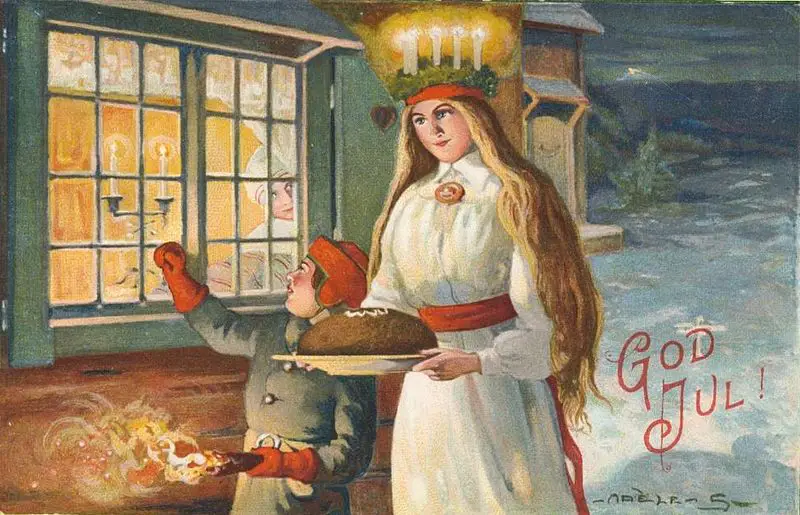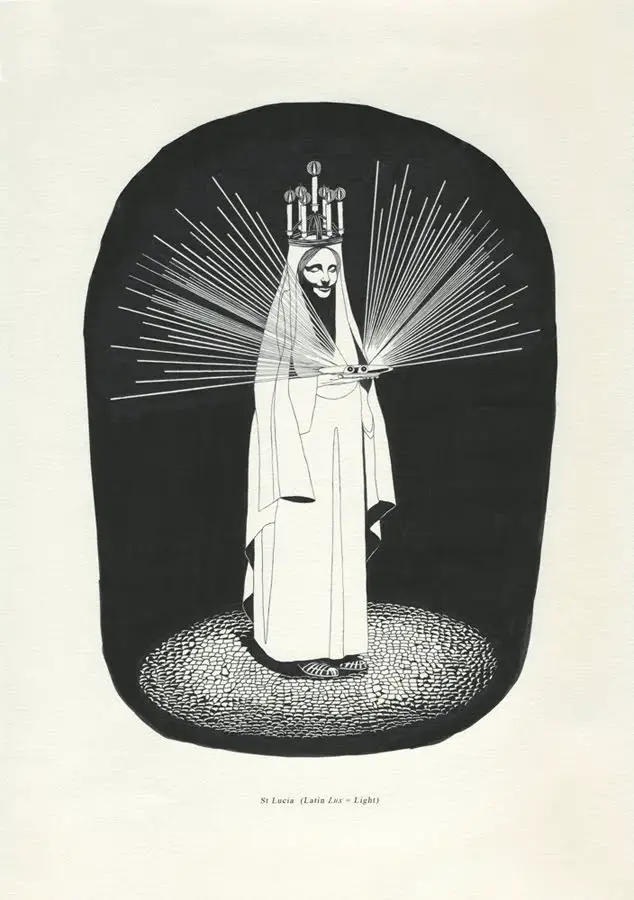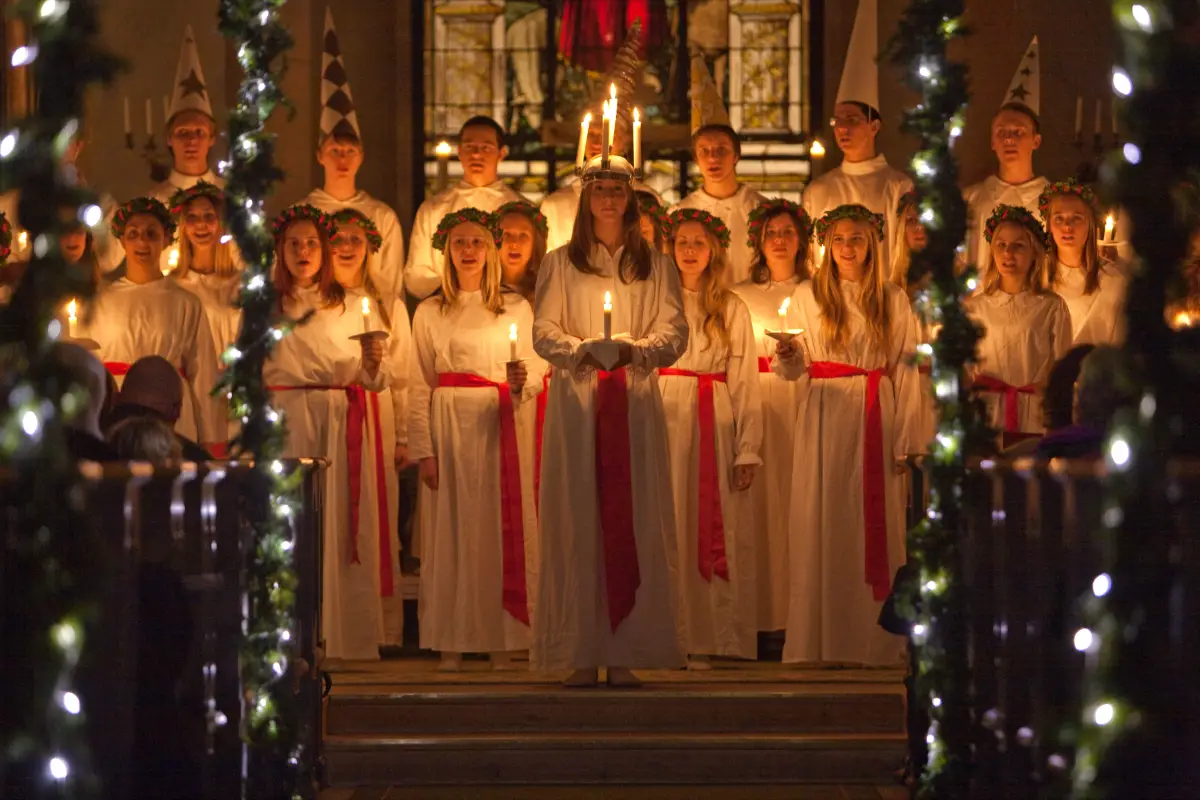Although many know the Christian tradition of Saint Lucia and celebrated it as children according to the most recent customs, most of the time the pre-Christian substratum from which this holiday, and the numinous figure used to it, derives, is ignored.
di Marco Maculotti
The feast of Saint Lucia, which falls according to the Gregorian calendar the night of December 13th, is considered of primary importance in the period of the so-called Advent, the liturgical time, between 3 and 24 December, which precedes Christmas. Yet, although many know the Christian tradition of the saint and celebrated her as children according to the most recent customs, the pre-Christian substratum from which this holiday, and the numinous figure used to it, derives, is often ignored.
A quick glance at the geographical areas where traces of a homologous pagan festival are found on the night of December 13 (Scandinavia, Germany and Northern Italy) would lead to think that the pre-Christian tradition regarding Lucia may be a Lombard cultural heritage, a people who from the XNUMXst century BC, the period in which he was stationed in Scandinavia, he progressively descended to Italy, where he mainly occupied the northern area.
The analysis we propose here will attempt to reconstruct the mythological-folkloric corpus of this pre-Christian tradition which has well-defined characteristics, and still in vogue until a few centuries ago, in the whole geographical area we have mentioned.
Lussi and the Langnatt
The ancient Norse peoples considered the night between 12 and 13 December the beginning of the month of Yule: from this moment on the darkness descends ever more threateningly over the fields and villages, giving the impression of a regression into the chaos and indefinite that precedes creation (this is a classic theme of the pre-Christian holidays of this moment of 'year). It should be noted immediately that the phase par excellence in which the forms seem to regress in the darkness, and therefore in the primordial chaos, coincides with the 12 days [1] between December 25 (Yule - Christmas) and January 6 (Perahta - Epiphany). In this sense, we can consider the days between December 13 and 25 - also, it will be noted, in number of 12 - as an anticipation of the following ones.
Not infrequently the populations of Central Europe (Central European Europe and Northern Italy) also experience a third phase, which runs from 6 January to the last week of the month. On the last Thursday of the month there is the custom, for example in northern Italy, of burning the Giöbia or Giubiana, an archetypal figure that represents nothing but the "Old Winter Woman", whose ritual elimination marks the end of the regression into chaos and darkness and therefore the real beginning of the year, which brings with it the idea of a return of light to earth. Etymologically, its name derives from the complex «Diana-Jana-Janua», goddess of the door-transit of the new year, as well as her male counterpart Janus, god of the beginnings and of the first month of the year, January.

According to the Scandinavian tradition, on the night of December 13, Mali Lošinj, is the longest night of the year (for this reason it was also called Langnatt, "Long Night"), as well as the darkest and most dangerous. It is believed that this night is ruled by Lussi ("Light"), a female spirit also considered as the Mother / Queen of the spirits of the afterlife and entities typical of the European foklore such as elves, gnomes, fairies and trolls, which she leads behind. itself in a kind of phantom procession (Lussiferde).
It is probable that this legend is connected with the widespread myth of "Wild Hunt" (called Oskoreia in Scandinavia), which you want to be conducted by Odin as "Lord of Winter" [2] or from its female counterpart Bertha / Pertcha, evidently connected to the Lussi we are dealing with here. Note here, with the scholar Emanuela Chiavarelli is [3]:
« Perctha recalls the Greek Fates, the Germanic Norns, the Baltic Lamias and the triple Celtic Birghit. Like Diana - whose subsequent relationship with the fairies undoubtedly reaffirms her dominion over her fate - she favored births and brought about death and regeneration. Behind this figure is hidden Berchta (from berth = "clear", "luminous"), the archaic progenitor of the Germans, the divine spinner whose name refers to both Bertha from the "great feet", mother of Arthur, and to the homonymous parent of Odin-Wotan, the Berta celebrated on January 2, when the sun has now overcome the crisis of the winter solstice. "
According to tradition, it is precisely in the period of the year when darkness descends threateningly on the earth, namely the month of Yule, that it is possible to come across this sinister procession: it is believed that this is the time of year when the boundary between the world of the living and the world of the dead (and of spirits and fairy entities) is not well defined, which is why it is considered the most dangerous of the year. Also note how probably this procession is connected with the best known Dianaticus, procession of damned souls and fairy beings known from the Central European tradition led by the goddess Diana, homologous at this time of the year to the "Old Winter Woman" Bertha / Pertcha [4].
Either way it was believed that, during the Langnatt, children who had not behaved properly could be kidnapped by Lussi and, after being led up the chimney, taken to the world of the dead. Probably this belief is connected with the function distributive of the Befana that, if on the one hand he brings gifts to children who have behaved well, on the other hand he punishes others by bringing them coal (there is perhaps a connection between coal, whose black color once again symbolizes the darkness of regression into chaos, and the chimney, which during the night in question acts as a "passage" between the world of the living and the world of the dead, so to speak).
Lussi also verified that the preparations for the great festival of Yule were respected, and if not, he had the right to punish the lagging families. On this night it was also strictly forbidden to perform any kind of work: human activity had to stop, "freeze" as nature itself lay motionless, "frozen" in view of a new "beginning".
This was also believed to be the only night of the year when animals could talk (a belief that in Italy mostly concerns Christmas Eve and Epiphany, the other two topical festivities of the "solstice crisis"): they chat among themselves exchanging opinions on their masters and on the treatment they reserve for them. For this reason, it was advisable to treat them better than usual, give them better food and clean the barn thoroughly.
From Lussi to Santa Lucia
With the advent of Christianity in Northern Europe the "Long Night" became the celebration of one Syracusian saint martyred during the XNUMXth century of our era: S. Lucia, whose name has the same "Luciferian" value as Lussi. St. Lucia, adorned with a crown of candles (4 or 12 in number, like the seasons or months of the year), literally symbolizes the "Bringer of Light", although this may seem like an oxymoron on the surface:
« Santa Lucia, the darkness take away. »

Yet, as we know, the pagan mentality was somehow founded on these apparently irreconcilable polarities which instead, to a more attentive eye, revealed esoteric truths on the functioning of the cosmos and of nature. In this regard, speaking of the "Old Winter Woman", we can again quote the opinion of the Chiavarelli, according to which [5]:
« In this mysterious old woman, the ancient goddesses who have fallen into witches, astrologers and priestesses like Medea, Circe, Pasifae, Arianna ... and all the other "Daughters of the Sun", brides, daughters and mothers of the star, are revealed to be involved in regenerating the year "remembering it ", That is, capturing the sun in the solar" cauldron "to" refuse "it to the heat of the fire. »
In this regard, we can see a plausible symbolic connection between the solar "cauldron" (and perhaps also the witches' cauldron) and the fireplace through which Lussi kidnaps "bad" children, both being symbols of the loci in which lies the fire-sun-year which, although it lies extinguished at the moment, is destined to ignite again, renewed, within 12 days.
Guido von List wrote that Yule is [6]:
«… The last month of the annual cycle in which there is the shortest day and the longest night, the great maternal night in which the new sun, that is, the new time, is conceived. "
In this sense, therefore, Lussi appears as the "Mother of the New Sun" and for this reason, although described as a "terrifying" deity in the guise of an old woman or a witch, she is called "Light" and is considered the "Bringer of Light" and of solar renewal, as [7]:
« In the playful and illusory rhythm that the mistress of becoming manages, life and death constitute only opposite aspects of the process, complementary phases functional to each other so that the vital energy continues to flow, renewing itself periodically in its infinite appearances. »

It is interesting to note that the transition from the pagan to the Christian festival did not take place in a well-defined temporal way. We know for sure that in Sweden the belief in Lussi was still alive during the thirteenth century, so almost a thousand years after the martyrdom of St. Lucia. Furthermore, although Christianity began to take root in Scandinavia around the year 1000, the festival as we know it today only took hold in the last few centuries, roughly starting from the end of the 1898th century (in Denmark in 1927, in Sweden in 1944, in Denmark in XNUMX and in Norway after the Second World War). In this regard, it is curious that still today in Sweden the melody of a traditional Neapolitan song titled is sung for this occasion Saint Lucia, which dates back to 1849.
It is therefore reasonable to assume that in this enormous period of time lasting many centuries, the ancient pre-Christian beliefs persisted, especially in the more rural areas of Scandinavia, to finally synchronize with the Christian holiday only in the twentieth century.
Although much of the ancient symbolism has failed in the new Christian guise of the holiday, there is to be emphasized the "terrifying" aspect that the saint somehow it keeps, in connection with the pagan deity Lussi. In fact, it is believed that children cannot look at St. Lucia while she, arriving in their home, brings with her the gifts reserved for them, on pain of being thrown into the eyes of the ash that causes them a temporary blindness - this being perhaps connected to the topos of the deadly gaze of the "Lady of Winter", which follows a widespread belief in antiquity regarding female divinities so to speak "dark" and "terrifying" (think for example of the Medusa-Gorgon).
Even the fact that the saint appears deprived of the eyes, which she holds in her hand, has a "terrifying" and yet also symbolic value: the eyes, a solar symbol, are removed as the Sun seems to "die" at this time of the year, "disappearing" in the winter darkness. It will only be reborn on the night of Yule, December 25, when according to tradition, large fires will be lit throughout the village to celebrate the return of the (re) Rising Sun.
And yet, even if it "terrifies", this Lussi is, as we said, the one who conceives this New Sun: hence its denomination of «Luminosa». It is linked to this belief the custom in vogue today to cook a particular type of dessert during the night of St. Lucia, i Lussekatter, yellow in color like the sun and light, formed by a double spiral, once again conveying the idea of one periodic rebirth, of a cyclical resurrection [8].
Note:
[2] See. Cernunno, Odin, Dionysus and other deities of the 'Winter Sun'.
[3] Emanuela Chiavarelli, Diana Arlecchino and the flying spirits. From shamanism to the "wild hunt". Bulzoni, Rome, 2007, p. 122.
[4] See. The Friulian benandanti and the ancient European fertility cults.
[5] Chiavarelli, op. cit., p. 195.
[6] Guido von List, The religion of the Ariogermans and Urgrund. Settimo Sigillo, Rome, 2008, p. 55.
[7] Chiavarelli, op. cit., p. 122.
[8] See. The symbolism of the Spiral: the Milky Way, the shell, the "rebirth" e The double spiral and the double movement of emanation and reabsorption of the cosmos.

6 comments on “Lussi, the "Luminosa": the double pagan and "obscure" of Saint Lucia"